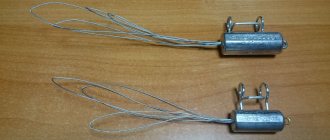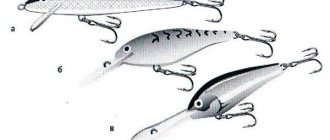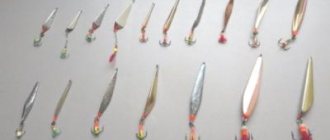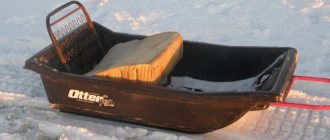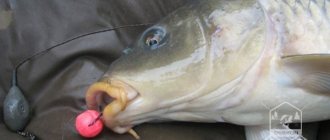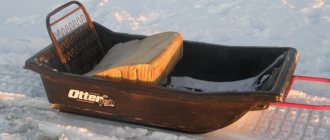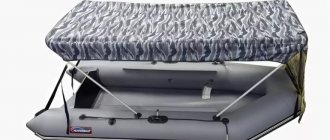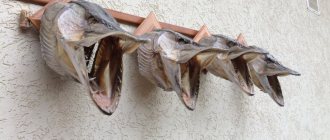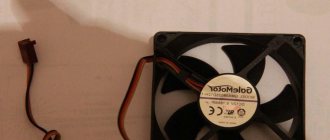Yuri 09/28/2020 1961
High-quality winter gear is not available to every fisherman. The bait often clings to snags or other underwater obstacles. A fishing hook will help you free caught gear and preserve an expensive and rare device. This accessory is effective in winter. Let's look at how the release works and whether it is possible to make it yourself.
Easy release
I also use this plumb line model when summer fishing from a boat. It can be used for vertical trolling, spinning and float fishing. This type of hook can be used when fishing from steep banks, piers or pontoons.
For shallow places (up to two meters), it is advisable to use a cutter bent from thick wire.
Fishing. Information portal "LANDFISH"
People have written and will continue to write about how to fish in winter. I myself regularly try to highlight interesting aspects of winter and summer fishing, and always (if you read my articles) I try to describe some nuances, and not banal things that a person can independently study and understand. After all, any business has its secrets and nuances, and they are the determining factors and components of success. It is clear that no one has yet. If someone does not know what this rule is, then know: “Beginners are absolutely always lucky,” and this is a fact. For example, I witnessed how experienced fishermen “shelled” the bay, swept the entire territory - the pike did not bite. And then, the boy, who was taken fishing for the first time, threw a spoon spoon from his hand, and already on the second cast a pike weighing two kilos danced on the shore. Here is the rule in action. And this happens to newbies all the time.
What to do in winter, when a jig or winter spinner gets caught and freeing the tackle, at first glance, seems impossible.
That's right, unhook. But winter fishing has its own characteristics, which can be divided into those that contribute to a quick solution to the problem, and those that favor the breakage of gear (the fishing line is thin in winter). One of the advantages that makes it easier to free the tackle is that you are literally above the hook.
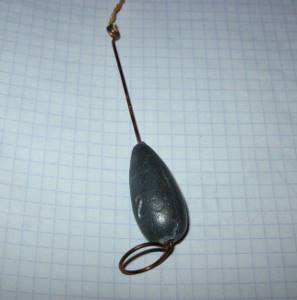
In my practice, I use a through olive sinker weighing from 30-50 grams, which I put on a rigid wire, at one end of which I form a ring, and the other end also has a loop, but is not tightly secured. The photo shows that thanks to the design of the lower part of the wire, you can lift the sinker, secure the fishing line of the snagged tackle on the lower ring, then reinsert the wire into the sinker and, after unwinding the required amount of nylon cord, lower the load to the point of the hook. Sudden lifting and lowering of the load. You can quickly release a caught jig. In practice, this happens in just 1-5 minutes. If you use a load of 100-300 grams, it is quite possible to free the spoon with a tee from the hook.

I believe that this kind of winter release has the right to exist, since it is easy to use, takes up little space, and does not require any dexterity or skills from the fisherman. Meanwhile, such a hook for winter fishing is indispensable when you go ice fishing for perch, especially in areas of sunken trees and bushes.
My opinion is that there should be such a cut in a fisherman’s fishing box. After all, it’s a pity to lose jigs, the cost of which can exceed 50-100 rubles. All the best to you!

Light plumb. Scheme of work
When fishing, you can tie it with electrical tape to a stick cut out on the shore. However, you can carry with you an old summer telescopic fishing rod without thin legs, then the depth of the cut will correspond to the length of the remaining legs of the rod. The work diagram is shown in the picture.
Using a homemade cutter not only helps you save money spent on purchasing spinners and balancers. Unhooking is the salvation of your favorite, reliable, proven baits over the years, the loss of which cannot be compensated for by any money.
Polyakov Yuri Nikolaevich - Specially for the SamodelkiFish website, Nizhny Novgorod, Russia
- Copper plating of spinners and jigs at home
- How to quickly and easily measure depths during winter fishing
Do-it-yourself ice fishing trailer
To reduce the risk of gear breakage when fishing in winter to almost zero, you can try making your own unhook. Using this device, you can save the tackle in case of a snag in most cases.
There are three types of winter unhooks in total, one is designed for saving small gear, for example, jigs. The second can be used to unhook spinners and cones, and the third is intended for balancers. Technically, such devices are not very different; they are a kind of hammer on a fishing line, which allows you to knock the tackle off the hook and thus release it. They differ mainly in weight, because it is much easier to knock down a jig than a wobbler or spinner. Well, there is also a difference in terms of attachment to the fishing line.
The release for balancers weighs about 150-250 grams, for cones and spinners from 70 to 150 grams. Well, for jigs a weight of 30-70 grams is enough. When choosing a weight, it is important to take into account that a cut that is too heavy can break the line when hit.
The process of making a cut:
Step one. Preparing the body
The author used a brass tube as the body (base); in general, a tube with an outer diameter of 12-18 mm and a wall thickness of up to 2-2.5 mm is suitable for such purposes. It is better that the wall thickness is as thin as possible, otherwise it will be difficult to uncouple. The length of the tube should be cut to approximately 40-60 mm. If you do not plan to fill the body with tin, then the tube should be as heavy as possible.
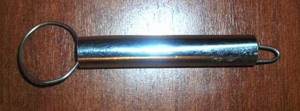
In principle, after making a pin, it can be inserted into the tube, after which the homemade product can already be used. But this design is not very reliable, and it weighs a little. Therefore, it is best to modify it by filling it with tin.
Step three. Fill with tin
To add strength to the homemade product and obtain the desired weight, tin or lead is poured into the tube. You can not fill it completely, but, for example, halfway. There are several ways to fill with tin. For example, the tube can be installed horizontally, the tin can be heated separately in a container and then poured into the tube. Or you can heat the tube itself by gradually throwing pieces of tin into it.
When the whole thing has cooled down, you will need to grind off the excess with sandpaper or a sharpener. After this, the homemade product is ready.
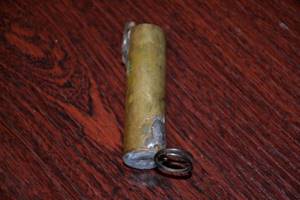
For ease of use, you will need to take a reel and wind a strong fishing line on it, and attach a release to the fishing line. Using the device is very simple. If you get caught on something at the bottom, you need to put the line behind the release pin, and lower the release itself to the bottom to the place of the problem, so to speak. And then make a couple of jerks upward, ensuring that the release falls freely onto the jig. As a result of the impacts, the tackle should become detached.
Here's another example of a wrench release
How long has it been since you had a really BIG CATCH?
When was the last time you caught dozens of HUGE pike/carp/bream?
We always want to get results from fishing - to catch not three perch, but ten kilogram pikes - what a catch! Each of us dreams of this, but not everyone can do it.
A good catch can be achieved (and we know this) thanks to good bait.
It can be prepared at home or bought in fishing stores. But stores are expensive, and to prepare bait at home, you need to spend a lot of time, and, to be fair, homemade bait does not always work well.
You know that disappointment when you buy bait or prepare it at home and only catch three or four bass?
So maybe it’s time to use a truly working product, the effectiveness of which has been proven both scientifically and in practice on the rivers and ponds of Russia?
Fish Megabomb gives the same result that we cannot achieve on our own, especially since it is cheap, which distinguishes it from other means and there is no need to spend time on production - you order it, it’s delivered and you’re good to go!
Of course, it is better to try once than to hear a thousand times. Moreover, now is the season! A 50% discount on your order is a great bonus!
Find out more about the bait!
We suggest you read: How to make shish kebab from catfish
Making a fishing hook with your own hands
A hook caught at depth while fishing is a common occurrence. Fishermen have come up with many ingenious devices for releasing spinners, jigs, and hooks.
Some fisherman, using expensive purchased gear, lose it due to the lack of a release, breaking the line when trying to force the tackle off. A true amateur always has his own homemade bait or jig and, in order not to lose it when fishing, takes a cut with him as an obligatory attribute of fishing.
Many fishing publications describe various cuts, but I have never seen anything like the one I promote in the Arkhangelsk region. I live in the ancient city of Solvychegodsk, located on the Vychegda River. At one time, the outstanding ichthyologist S.P. Sabaneev glorified our river because of all the Russian reservoirs it was home to the largest pike.
And today, the wastewater from the Kotlas pulp and paper mill has destroyed all the fish in Vychegda and we are forced to travel 100 kilometers to go fishing. We catch perch and pike with rods and vertical lures. Those places abound in snags, flooded willows and floating logs. Uncoupling is absolutely necessary in these conditions.
I came up with a heavy release with two cones. The lower cone is more pointed, allowing unhindered unhooking in any water thickets to a hooked spoon or jig. The reverse cone allows you to safely remove it with free gear. I insert a wire (knitting needle) Ø1 mm into the inner hole of a lead conical blank weighing 300-400 g.
At the top of it I bend a ring for attaching the nylon thread of the release, and at the bottom there is a tendril into which I insert the fishing line of the stuck spinner. The antenna moves into the hole of the blank. The unhooking thread is tied and wound on a reel made of five-layer plywood 120-150 mm long. An artificial leather cover was attached to it for storing the blank. The reel was painted in a contrasting color: black for winter, and red for summer. For winter fishing, where a small jig is used, the release blank is lighter (80-100 g).
Any angler can make a release at home. Molten lead is poured with all precautions into a thick paper cone cup. A hole in the blank can be drilled with a thin drill or made directly during casting by inserting a knitting needle lubricated with a mixture of soap and graphite (a pencil lead crushed into dust) inside the cup. For knitting needles, it is better to take nichrome wire - it is durable and does not rust. After casting, the blank must be processed with a file, giving the reverse cone the desired shape.
N. Bykov, Arkhangelsk region. Based on materials from the magazine “SAM”
How to make a release from a tube
The most inexperienced fisherman can make a cut from a tube of suitable size. The time it takes to make a fishing device will depend on which method you choose and what mass of homemade hook suits you best.
It is clear that for unhooking jigs it is better to make a device from a tube with small dimensions, but in order to remove a spoon or balancer from a snag we need a heavier fishing device.
Also, the time will depend on the component materials needed to make a do-it-yourself detachment for winter or summer fishing.
Therefore, before you and I start making the cutter, let’s first decide on the purpose of a homemade fishing assistant for winter or summer fishing. And, based on the purpose, let’s estimate what dimensions of the tube and wire striker - rings a homemade cutter should have.
For an example of how to make a detachment with your own hands in five minutes, see the video Making a fishing detachment from a tube on my YouTube channel.
Communities › Hunting and Fishing › Blog › Do-It-Yourself Cuttings
Finally, I collected all the components in a pile and had some free time! For the uncouplings, I needed 3 mm stainless steel electrodes, aluminum tubes, steel wire, a large tee, a 2 mm stainless steel rod, old lead weights for balancing wheels, a nylon cord of 25 meters ! Of course, on the Internet there is a lot of information about cut-offs, but there is very little manual for making them! You can also buy them in a store, but why buy when you can make them yourself! Moreover, I don’t remember anyone here raising this topic, maybe I missed it, I think will not be superfluous! Maybe someone else will share their cut designs!
see also
Tags: fishing-cuts
Specifications
Surely every novice fisherman is faced with the problem of hooking the bait during the bite process. At this time, the fishing bait may get caught on a snag or other underwater object. An inexperienced fisherman begins to try to extract this element from the water column, making sudden movements. This provokes a break in the fishing line and the loss of an expensive part.
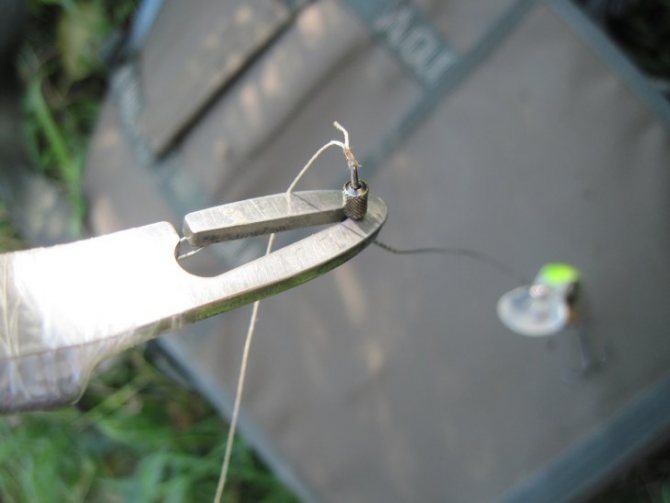
The best brands of releases for wobblers and spinners allow you to avoid an unpleasant situation. This design is an unusual and at the same time unique fishing accessory. While diving in the water column, it quickly releases the fishing bait from the hook.
«>

During the hooking process, the bait moves along with the fish to the unhooking area. If the caught fish breaks away, the bait will remain inside the structure. To date, more than a hundred types of this accessory have been developed.
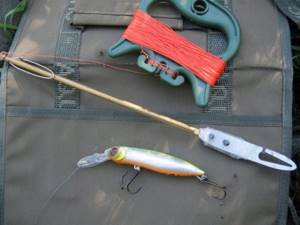
Finished design
In their design, the releases differ primarily in what type of piece bait they are intended for.
For lures that have a blind hook fastening at the end, cutters with a narrow loop are used. When lowered into the water, they hit the top of the bait, thus releasing the hook. If the bait is equipped with a tee, which is attached on a hinge, movably, then in this case the hook with a narrow loop, hitting the bait itself, will only cause depreciation of the movable tee, and the hook will not be released. Therefore, for this type of bait it is necessary to use hooks of a different design - with a loop of a larger diameter, which, when lowered into the water, will pass the body of the bait through itself and will hit directly on the hooked tee itself.
Accordingly, in the arsenal of a winter ice fishing enthusiast it is necessary to have both types of cuts. Also, depending on what kind of bait the hook is used for, the weight of the weight should vary - for example, for light winter jigs with a small hook, a weight of about 50 grams will be enough, for medium-sized spinners the weight of about 70 grams will be optimal, but for larger ones spinners and balancers aimed at large predators, the weight of the sinker can be more than 100 grams.
We pass the wire from top to bottom to the ring. We bend the ring from below and bend the wire so that its end almost reaches the hole in the weight from below. We bite off the excess wire.
How long has it been since you had a really BIG CATCH?
When was the last time you caught dozens of HUGE pike/carp/bream?
We always want to get results from fishing - to catch not three perch, but ten kilogram pikes - what a catch! Each of us dreams of this, but not everyone can do it.
A good catch can be achieved (and we know this) thanks to good bait.
It can be prepared at home or bought in fishing stores. But stores are expensive, and to prepare bait at home, you need to spend a lot of time, and, to be fair, homemade bait does not always work well.
You know that disappointment when you buy bait or prepare it at home and only catch three or four bass?
We invite you to familiarize yourself with: Diagram and equipment of an onboard fishing rod for catching bream from a boat in different ways
So maybe it’s time to use a truly working product, the effectiveness of which has been proven both scientifically and in practice on the rivers and ponds of Russia?
Fish Megabomb gives the same result that we cannot achieve on our own, especially since it is cheap, which distinguishes it from other means and there is no need to spend time on production - you order it, it’s delivered and you’re good to go!
Of course, it is better to try once than to hear a thousand times. Moreover, now is the season! A 50% discount on your order is a great bonus!
Find out more about the bait!
Current tube release size
A fairly large heavy unhooking hook is designed for unhooking pike tees and my homemade pike perch spinners of various sizes. And in what kind of wilds of drowned trees and at what depth and strength of current the pike perch sometimes feeds, you yourself know very well.
For this reason, the dimensions of the tube of my current release were chosen such that, under the influence of its own weight, the homemade fishing device could freely slide between the branches of flooded trees.
In order to further increase the cross-country ability, the ring of the release striker can be flattened, giving it the shape of a highly elongated ellipse, but then the bodies of my homemade oscillating pike lures with large widths and the tees of the balancers will slip through its cavity worse.
For fishermen who fish exclusively with a jig, the size of the tube, and therefore the pin, can be proportionally reduced. Moreover, their dimensions of homemade cutters are not critical.
On the next page, a homemade fishing hook with a lighter layout and smaller dimensions is presented in a working assembly, also intended for knocking out both jigs and spinners from snags, but more suitable for fishing at shallow depths in a reservoir without a current.
Use the link below to check out the homemade cut in action on the YouTube channel. Like and subscribe to watch new videos.
CONTINUATION OF THE TOPIC:
Do-it-yourself jig release
***
